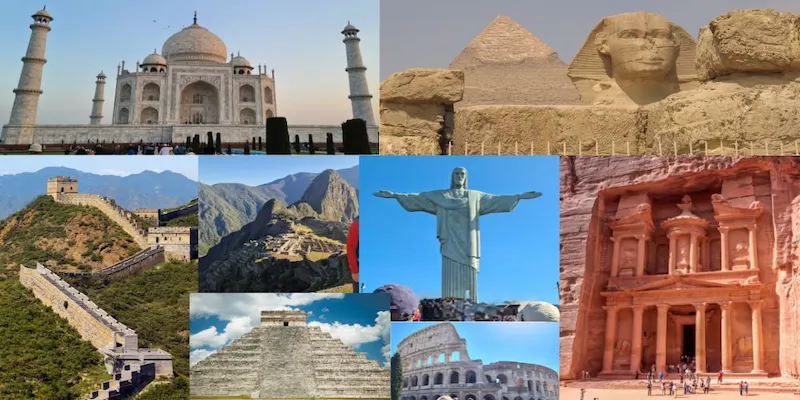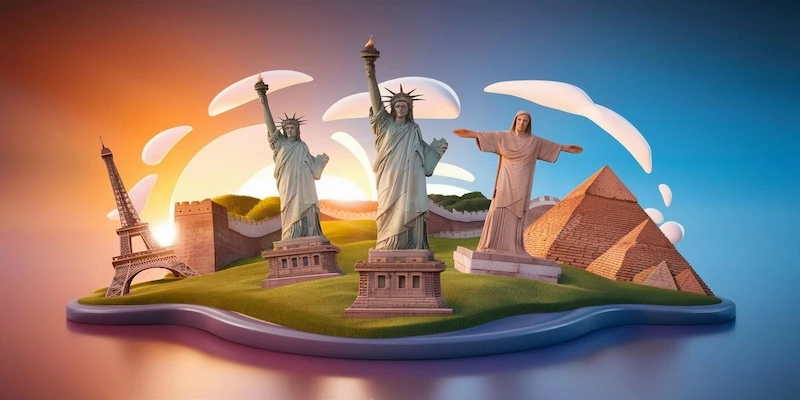Exploring the 8 Wonders of the World: A Journey Through History and Culture
Updated: July 13, 2024
105
The world’s eight phenomena refer to a list of great attainments or natural phenomena deemed unique regarding their looks, size, or historical significance. These wonders delight the vision and respect of people worldwide, representing human creativity and the awe-inspiring force of character.
Brief History of the 8 Wonders of the World
Collecting lists of marvels dates back to antiquity, with the old Greeks making lists such as the Seven Wonders of the Ancient World. Over time, various cultures and societies have developed their list performances, topping the concept of the world’s eight wonders, including ancient and wild surprises.
The Significance of the 8 Wonders of the World
The eight wonders symbolize human creativity, creative prowess, and the incredible beauty of nature. They serve as creative icons and tourist interests, drawing millions of tourists yearly and stressing the extent of protecting these prizes for future years.
Explanation of the Difference Between the 7 and 8 Wonders of the World
The Seven Wonders of the Ancient World were all fabricated structures, particularly from the Mediterranean and Middle Eastern regions. In distinction, the modern list of phenomena includes a mix of recorded and recent buildings from various parts of the world, known as the New 7 Wonders of the World. The “8th Wonder” idea extends outside these to identify other extraordinary feats or biological marvels that, while not officially listed, are equally amazing.

8 Natural Wonders of the World
While the focus has often been on synthetic wonders, the untamed world also offers excellent spectacles. These include the US Grand Canyon, the Great Barrier Reef in Australia, and Mount Everest in Nepal. Some of these uncultivated wonders showcase the Earth’s looks and variety, reminding us of the world’s sovereignty and the demand for protection.
The Great Wall of China
Importance and Significance of the Great Wall
The Great Wall of China, an iconic character of Chinese invention and industry, was created to protect the northern edges of the Chinese Empire from raids. It represents the joining of China under Emperor Qin Shi Huang and stands as a testament to the country’s recorded strength.
Facts and Figures About the Great Wall
- Length: About 13,170 miles
- Building Period: Over several dynasties, primarily during the Ming Dynasty (1368–1644)
- Material: Rock, brick, tamped Earth, wood, and other fabrics
Petra, Jordan
History and Architecture of Petra
Petra, frequently referred to as the “Rose City” due to the shade of the stone from which it is carved, was the means of the Nabataean Kingdom. Fixed around the 4th century BCE, Petra is recognized for its complex rock-cut architecture and designed water conduit design.
Why Petra Is Considered One of the Wonders of the World
Petra’s unique tombs, temples, and complex water plans show remarkable engineering and artistry, making it acclaimed as one of the world’s wonders.
Christ the Redeemer, Brazil
Description and Significance of Christ the Redeemer
Christ the Redeemer is a colossal figure of Jesus Christ in Rio de Janeiro, Brazil. It stands as a sign of Christianity and Brazilian artistic originality, watching the city from the meeting of Mount Corcovado.
Architectural Features and Interesting Facts About the Statue
- Height: 98 floors (30 meters) tall, with a 26-foot (8 meters) pedestal
- Arms Stretch: 92 feet (28 meters) broad
- Material: Girded concrete and soapstone
- Finished: 1931
Machu Picchu, Peru
History and Cultural Importance of Machu Picchu
Machu Picchu, an old Incan city in the Andes Mountains, was established in the 15th century and dumped after that. Hiram Bingham rediscovered it in 1911, making it one of the most important archaeological sites in the world.
Unique Features and Architectural Marvels of the Site
- Location: 7,970 feet (2,430 meters) past sea level
- Systems: Terraces, temples, and astronomical towers
- Structure: Dry-stone design, with precisely cut stones working jointly without guns
Chichen Itza, Mexico
Significance and History of Chichen Itza
Chichen Itza was a principal city of Mayan culture between the 9th and 12th centuries. It was a political, financial, and spiritual center featuring unique architectural and astronomical triumphs.
Notable Structures and Architectural Features of the Site
- El Castillo (Temple of Kukulcán): A pyramid with 365 grades representing the Mayan calendar
- The Great Ball Court: The most important and most challenging ball court in Mesoamerica

The Roman Colosseum, Italy
Historical Significance and Events at the Colosseum
The Roman Colosseum, an iconic symbol of Ancient Rome, was used for gladiatorial contests, public processions, and other occasions. It was built between 70 and 80 CE and could hold up to 80,000 viewers.
Architectural Features and Engineering Marvels of the Structure
- Structure: Elliptic theatre made of concrete and sand
- Extents: 620 feet (190 meters) long and 513 feet (155 meters) expansive
- Features: Complicated system of vaults and tunnels, retractable awning for coloring
Taj Mahal, India
History and Romantic Story Behind the Taj Mahal
The Taj Mahal, found in Agra, India, was approved by Emperor Shah Jahan in 1632 as a mausoleum for his darling wife, Mumtaz Mahal. It is a character of everlasting love and one of the most spectacular structures in the world.
Architectural Design and Unique Features of the Monument
- Material: White marble with unique stone inlays
- Features: Balanced design, skipping pools, and a big green
- Crown: 115 feet (35 meters) elevated
The Great Pyramid of Giza, Egypt
Construction and Mysteries of the Great Pyramid
The Great Pyramid of Giza, built about 2560 BCE for Pharaoh Khufu, is the senior of the Seven Wonders of the Ancient World and the only one still primarily intact. Its construction designs remain a subject of research and passion.
Significance and Historical Context of the Pyramid
- Height: Initially 481 feet (146.6 meters), now 455 feet (138.8 meters)
- Base: 755 feet (230 meters) on each side
- Fabrics: Limestone and granite, with an evaluated 2.3 million blocks used
The 8 Wonders of the Modern World
In 2007, an international poll executed by the New7Wonders Foundation placed a new list of surprises to celebrate modern attainments in architecture and engineering.
- The Great Wall of China: An expansive fortification built to defend China from attacks represents strength and endurance.
- Petra in Jordan: An antique city carved into rose-red ridges by the Nabateans, Petra is understood for its dazzling rock-cut architecture and recorded value as a business hub.
- Christ the Redeemer in Brazil: A tall statue of Jesus Christ in Rio de Janeiro, representing peace and receiving visitors worldwide.
- Machu Picchu in Peru: An old Incan city set high in the Andes Mountains, famous for its cosmopolitan dry-stone structure and stunning location.
- Chichen Itza in Mexico: A large pre-Columbian archaeological site built by the Maya culture, featuring the iconic pyramid of El Castillo.
- The Roman Colosseum in Italy: This old theater in Rome is understood for its architectural grandness and historical importance as a venue for gladiatorial games.
- The Taj Mahal in India is a white marble mausoleum built by Mughal Emperor Shah Jahan to remember his wife, Mumtaz Mahal. It represents eternal love and architectural magnificence.
- The Eiffel Tower in France: Although not officially part of the New 7 Wonders inventory, the Eiffel Tower is often formed as a cultural icon of modern engineering and French artistry.
The Future of Wonders
Glancing forward, the purpose of wonders persists to evolve with technical progress and global challenges.
The Burj Khalifa in Dubai
The world’s highest tower, the Burj Khalifa, stands as a sign of modern engineering and architectural merit, pushing the limits of building design.
The Amazon Rainforest
The Amazon Rainforest is a vital ecosystem of exceptional biodiversity. However, it faces dangers from deforestation and climate change. Its protection and sustainable management are crucial for global biodiversity and weather peace.
Conclusion
From the old Great Pyramid of Giza to the current Christ the Redeemer, the world’s eight wonders define humanity’s numerous great attainments in architecture, engineering, and artistic expression. Each splendor tells a unique story, remembering the importance, beliefs, and powers of the cultures that made them. These marvels have stood the test of time and shaped mortal history, culture, and individuality. They rouse awe and interest, enabling us to study and enjoy the amazing feats of our predecessors and contemporaries.
FAQ
What are the eight wonders of the world?
A: The eight wonders of the world are the Great Wall of China, Petra in Jordan, Christ the Redeemer in Brazil, Machu Picchu in Peru, Chichen Itza in Mexico, the Roman Colosseum, the Taj Mahal in India, and the Great Pyramid of Giza in Egypt.
How were the eight wonders of the world chosen?
The Earth’s eight phenomena were chosen through recorded value, architectural beauty, and artistic importance.
Are the eight wonders of the world still standing?
The world’s eight surprises remain today, although some have experienced extensive rehabilitation and conservation efforts.
Can I visit the eight wonders of the world?
The world’s eight wonders are available to visitors, and numerous are popular tourist goals.
Are there other lists of wonders of the world?
Numerous other lists of world surprises exist, including the New7Wonders of the World and the Seven Natural Wonders of the World.
Please Write Your Comments